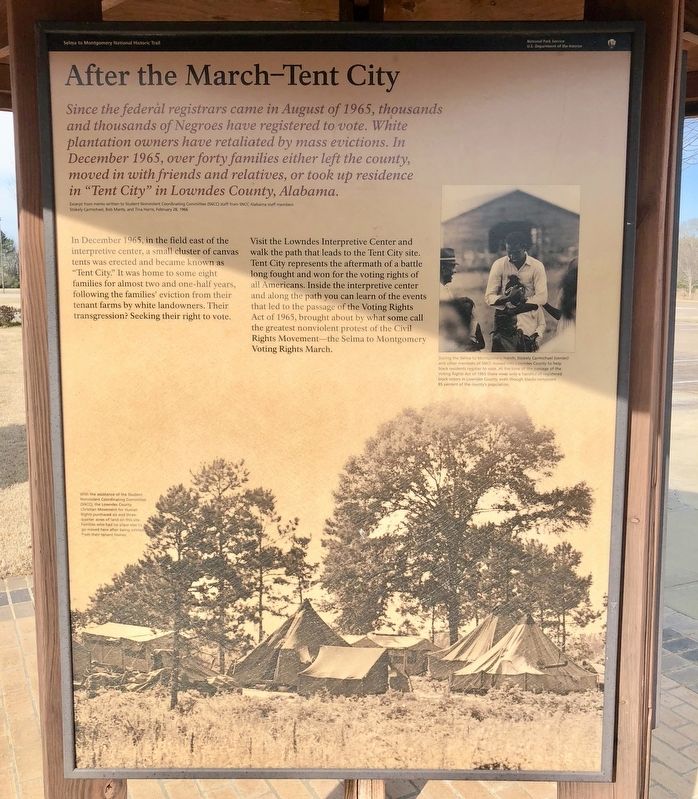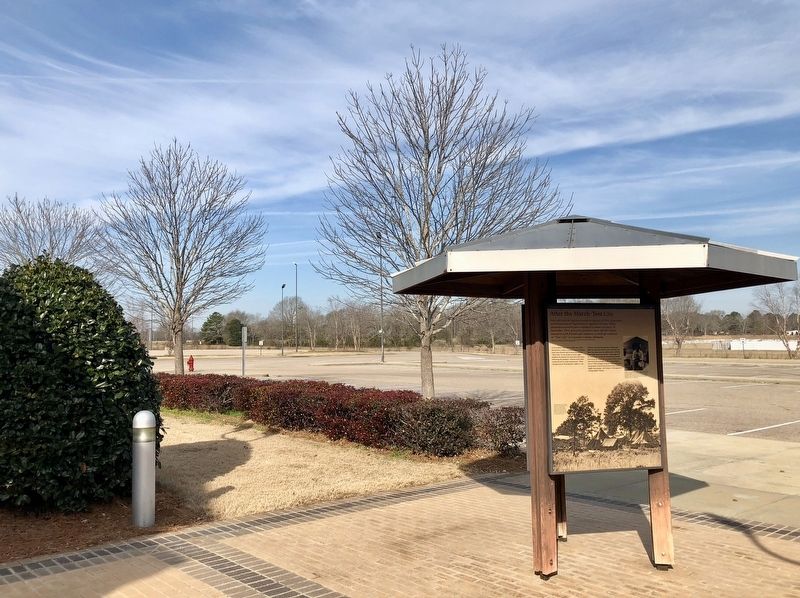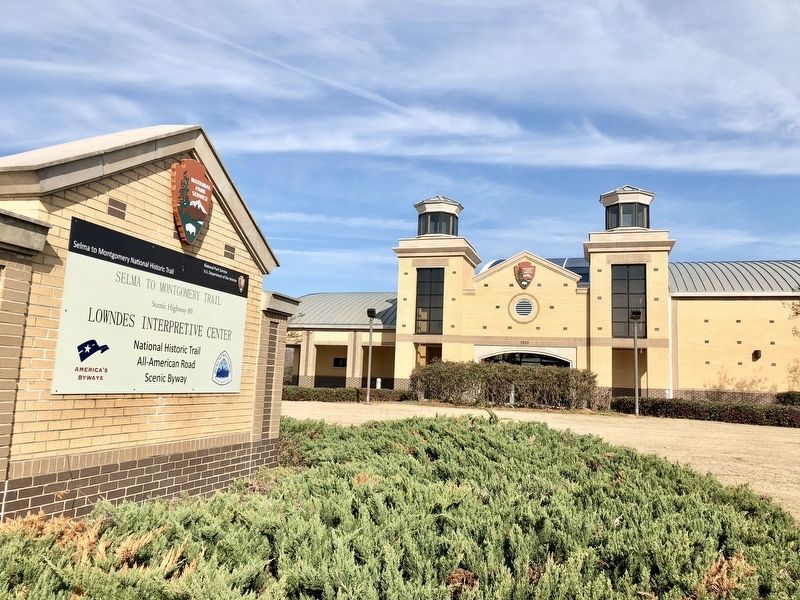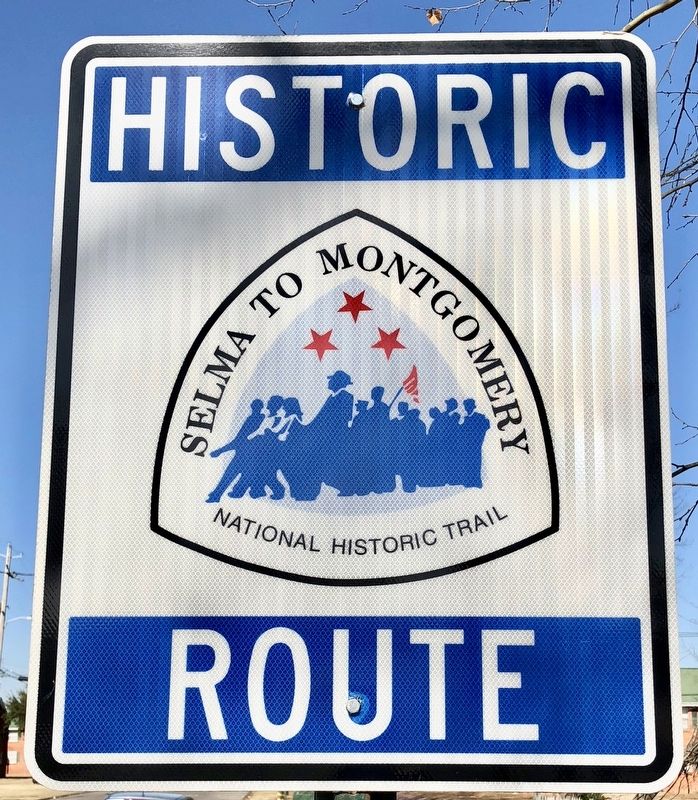White Hall in Lowndes County, Alabama — The American South (East South Central)
After the March—Tent City
— Selma to Montgomery National Historic Trail —
Excerpt from memo written to Student Nonviolent Coordinating Committee (SNCC) staff from SNCC Alabama staff members
Stokely Carmichael, Bob Mants, and Tina Harris, February 28, 1966
In December 1965, in the field east of the interpretive center, a small cluster of canvas tents was erected and became known as "Tent City" It was home to some eight families for almost two and one-half years, following the families' eviction from their tenant farms by white landowners. Their transgression? Seeking their right to vote.
Visit the Lowndes Interpretive Center and walk the path that leads to the Tent City site. Tent City represents the aftermath of a battle long fought and won for the voting rights of all Americans. Inside the interpretive center and along the path you can learn of the events that led to the passage of the Voting Rights Act of 1965, brought about by what some call the greatest nonviolent protest of the Civil Rights Movement—the Selma to Montgomery Voting Rights March.
During the Selma to Montgomery march, Stokely Carmichael (center) and other members of SNCC moved into Lowndes County to help black residents register to vote. At the time of the passage of the Voting Rights Act of 1965 there were only a handful of registered black voters in Lowndes County, even though. blacks composed 85 percent of the county's population.
With the assistance of the Student Nonviolent Coordinating Committee (SNCC), the Lowndes County Christian Movement for Human Rights purchased six and three- quarter acres of land on this site. Families who had no place else to go moved here after being evicted from their tenant homes.
Erected 2015 by the National Park Service, Department of the Interior.
Topics. This historical marker is listed in these topic lists: African Americans • Civil Rights. A significant historical date for this entry is February 28, 1966.
Location. 32° 16.242′ N, 86° 43.667′ W. Marker is in White Hall, Alabama, in Lowndes County. Marker can be reached from U.S. 80 west of White Hall Road. Located within the National Park Service Lowndes Interpretive Center. Touch for map. Marker is at or near this postal address: 7002 US-80, Hayneville AL 36040, United States of America. Touch for directions.
Other nearby markers. At least 8 other markers are within 2 miles of this marker, measured as the crow flies. It Started in Selma (here, next to this marker); You Gotta Move (within shouting distance of this marker); Day Two (about 300 feet away, measured in a direct line); Marchers, Supporters, Hecklers (about 400 feet away); A Price Paid (about 500 feet away); No Isolated Incident (about 500 feet away); Holy Ground Battlefield (approx. 0.2 miles away); Mount Gillard Baptist Church (approx. 1.1 miles away). Touch for a list and map of all markers in White Hall.
Regarding After the March—Tent City. Tent City, a settlement on black-owned property near Route 80 in Lowndes County, formed in 1965 for sharecroppers who were kicked off their land for voter registration activity. Tents were set up on the site to accommodate participants of the Selma to Montgomery march. Timothy Mays, a former Student Nonviolent Coordinating Committee (SNCC) worker and member of the Black Panthers in Lowndes County, and others worked to make sure Tent City inhabitants got fed. Mays also was instrumental in helping many of them find new housing. Mays became famous to the world on March 7, 1965 in Selma, Alabama. He was among the civil rights marchers who set out that day to cross the
Edmund Pettus Bridge and were beaten and tear gassed by Alabama State Troopers. News cameras were there when a State Trooper clubbed and knocked down Mays, who was carrying an American flag. Mays didn't drop the flag but held on to as a symbol of the injustice he and others had endured for the cause of freedom. Despite offers to buy the American flag for as much as $50,000, Mays would not sell it for any price. Instead, he promised to donate the flag to the Selma-Montgomery Historic Trail Interpretive Center. The flag and other of Mays memorabilia from the Civil Rights Movement can be seen at the center.
Credits. This page was last revised on November 9, 2021. It was originally submitted on January 7, 2018, by Mark Hilton of Montgomery, Alabama. This page has been viewed 1,187 times since then and 147 times this year. Photos: 1, 2, 3, 4. submitted on January 7, 2018, by Mark Hilton of Montgomery, Alabama.



